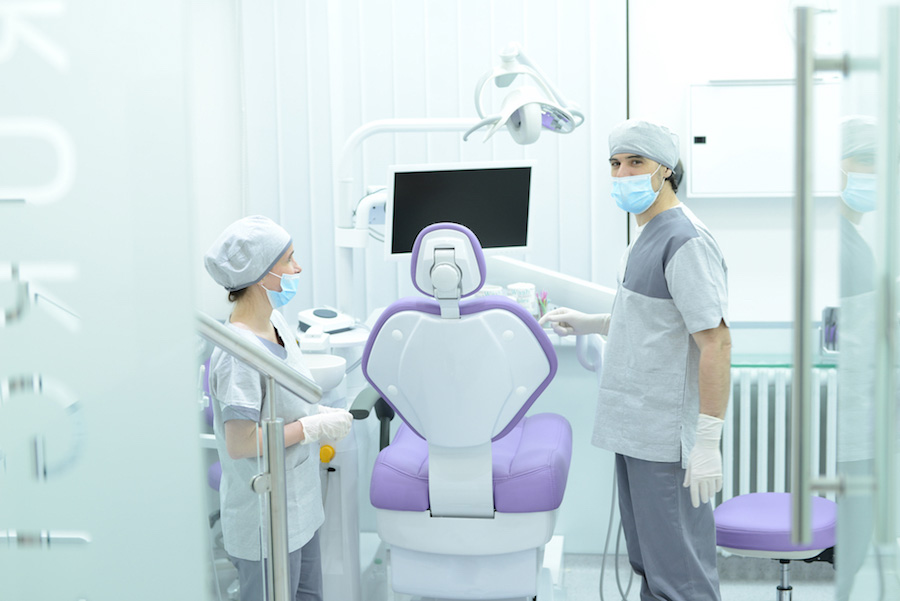The loss of a tooth creates a progressive resorption of the jaw bone. When bone loss is significant, dental implantology cannot intervene and place a dental implant in an area that is too narrow. It is necessary to perform a bone graft beforehand.
The principle of a dental bone graft is as follows:
• The graft is placed in The area where The lack of bone is felt.
• The graft is held still by one or more osteosynthesis screws.
• As time goes on, the graft will be replaced by newly formed bone.
• The graft and implant placement can sometimes be done together or it takes about 6 months for the bone to be renewed.
There are different types of bone grafts:
The autogenous graft:
• It comes from the patient him/herself.
• It will be taken from the area of the chin or wisdom tooth in case of minor need.
• If more important, it will be taken from the tibia or skull, but this type of operation is heavier and must be performed in a hospital setting.
The allogenic graft: it comes from a human being and is ordered in a specialized bank.
Xenogenic graft: it comes from cattle. This type of graft is widely used, safe and ideal for small bone deficiencies.
The alloplastic graft: it is of synthetic origin (tricalcium phosphates).
A dental bone graft performed in the jawbone (upper jaw) is easier to perform because the bone is more spongy.
Duration of hospital stay
1 to 3 hours.
It is recommended to have a few days to recover.
Average length of stay
3 to 5 days.
If it is a hip bone transplant, you should plan to stay longer.

Every year, nearly 11 million patients go abroad in search of medical care. At MEDICAIM, we provide our patients with access to the best hospitals and doctors around the world. Contact us to learn more about your treatment options.
Ask for your free quote abroad
Start your medical stay by requesting a quote. Our customer service department will help you find the clinic that best suits your needs and get you a quote.
A bone graft is performed during the extraction of the tooth itself and does not require any special preparation. In the event that the amount of bone grafting required is greater due to a bone recession, another appointment may be required to collect from the mouth or other appropriate locations such as the hip bone, tibia or skull.
Several sampling sites are possible, the choice of site depends on each case and is discussed during the consultation with the surgeon.
1) Head sampling: An incision is made in the scalp. The sample is taken from the upper bone layer of the cranial bone, respecting the deep layer that protects the brain. This procedure is practically painless and leaves no visible scar.
2) Iliac bone sampling: The incision is located at the level of the iliac crest and leaves a small scar. This swab is often painful and hinders walking and sports for a fortnight.
3) Mandibular sampling: It is performed on the lower jaw either in the chin area or at the angle of the jaws. The incision is made in the gum area.
The bone graft itself: the bone is placed either in the form of small blocks or in the form of crushed bone. Depending on the case, a biomaterial may be used in addition. The fixation of the grafted bone is done either by simple impaction or by using adapted equipment. Mucosal healing is achieved in 8 to 15 days. A small delay in healing is sometimes observed in the gums, which will justify continuing local care until complete healing. After the operation, the wearing of the dental prosthesis in the grafted area will only be allowed after agreement with the surgeon. It is necessary to wait 4 to 6 months before placing the implants. A CT scan will usually be performed before implant time to check the bone volume obtained.
The operation lasts between 1 and 3 hours depending on the type of transplant, it is performed under local anaesthesia or under general anaesthesia for bone grafts with tibia, hip or skull removal.

After the operation, facial edema is sometimes associated with bruised cheeks, the severity and duration of which vary from one patient to another. The pain is moderate. An analgesic treatment will be systematically given. Excellent oral hygiene is essential and mouthwashes are prescribed.
After each meal, the teeth and gums should be cleaned with a so-called surgical toothbrush. In the case of sinus bone grafting, significant and violent efforts should be avoided in the first few weeks. The diet should be soft, warm or cold. Avoid hot and very salty food. Smoking should be avoided before and after the procedure.
Any additional questions? Ask your MEDICAIM doctor about it: careteam@medicaim.com
Some needs and conditions are more complex than others. In case of doubt, please send us additional information to establish a customized quote.
Ask for a quoteCertains besoins et pathologies sont plus complexes que d’autres. En cas de doute, faîtes-nous parvenir des informations complémentaires pour établir un devis sur-mesure.
Demander un devisEntrust us with your medical file and it will be examined by a specialist doctor. The goal?
Allow you to evaluate all your treatment options.